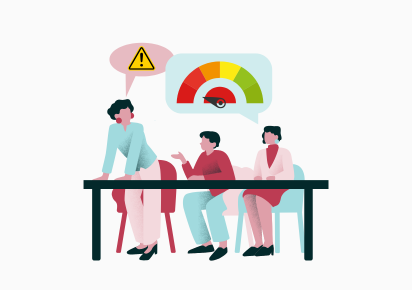Our Links Are Trusted By 2,500+ SEO Agencies
Our Links Are Trusted By 2,500+ SEO Agencies

Spam score is an SEO metric that indicates how likely your website is to be flagged as spam by search engines. The lower your spam score, the healthier your website is, making it more likely to rank well and maintain credibility online.
In this blog post, we’ll break down what spam score is, how to check it, and how you can improve it.
Spam score is a critical metric that influences a website’s search engine visibility. Ideally, your site’s spam score should be below 5% for the best performance.
Monitoring your spam score with tools like bulk checkers can help you manage your site’s health and reduce potential risks.
Several factors influence spam score, including the size of your website, backlink diversity, and the ratio of nofollow to dofollow links. Regular audits and best practices can help keep your score low.
The spam score metric rates the spam level of a page or domain in the eyes of search engines, with values ranging from 1% to 100%. Here’s how to interpret your spam score:
Low Spam Score (0-30%): A low spam score indicates that your website is in good standing with search engines. This suggests that your site is unlikely to be penalized, allowing you to focus on creating high quality content and building your website’s authority. Maintaining a low spam score is essential for long term success and credibility.
Medium Spam Score (31-60%): A medium spam score suggests that your website may have some issues that need attention. This could be due to factors like a lack of high-quality backlinks, thin content, or other minor infractions. It’s important to investigate the causes of your medium spam score and take corrective action to prevent it from escalating. Regular audits and improvements can help bring your score down.
High Spam Score (61-100%): A high spam score is a red flag, indicating that your website is at significant risk of being penalized by search engines. This could result from spammy backlinks, keyword stuffing, or other black hat SEO tactics. Immediate action is required to address the issues causing your high spam score. Removing harmful links, improving content quality, and adhering to white hat SEO are crucial steps to mitigate this risk.
An ideal spam score is below 5%, showing that your site is well-maintained with few spam indicators. High spam scores are often caused by black hat SEO techniques, which search engines disapprove of. This can lead to lower rankings, a drop in organic traffic, and even penalties from Google.
Therefore, monitoring your spam score regularly is essential to maintaining a healthy online presence and avoiding these negative effects. Keeping your site clean, following white hat SEO best practices, and conducting regular audits will help you manage your spam score and maintain a healthy online presence.
The first step in managing your spam score is identifying it. Spam score checkers are tools designed to analyze your website’s health by identifying potential spam factors. These tools provide a score between 0 and 100, where 0 indicates a clean website and 100 suggests fraudulent activity. By using a spam score checker, you can see whether your site falls into the low, medium, or high-risk category.
For those managing multiple websites, a bulk spam checker is essential. These tools allow you to check the spam score of up to 50 URLs at once, saving you time and effort.
Additionally, domain spam score checkers help evaluate and compare the health of different domains together. Regularly using these tools keeps you informed about your website’s spam score and helps you take timely action to maintain a healthy online presence.
Understanding the factors that influence your spam score is crucial for managing and maintaining your website’s credibility. Several signals contribute to your overall spam score, including website size, backlink profile, diversity of backlinks, and the balance between nofollow and dofollow links.
Let’s break down all the above factors to see how they can affect your spam score.
The size of your website and the quality of your backlink profile are key components in determining your spam score. Websites with a large number of pages that lack internal links may be flagged as spam, as search engines can perceive them as poorly structured or low in value. Therefore, building internal links between relevant pages is the perfect way to build the authority of your most valuable content, improving your spam score and overall site structure.
A strong backlink profile is equally important. External links are signals that other sites find your content worth linking to. A website with a robust backlink profile is less likely to be flagged as spam. As your site grows, maintaining a healthy backlink profile ensures you maintain a low spam score while enhancing your site’s credibility.
Backlink diversity is another critical factor. Search engines favor websites with links from a variety of sources, as it indicates a natural, organic link profile. A lack of diverse linking domains can lead to higher spam scores, as it often signals potential search engine manipulation. So, if your backlinks are mostly coming from the same domains may raise red flags and increase your spam score.
To reduce your spam score, focus on building backlinks from a wide range of relevant, high authority domains. This demonstrates your website’s credibility across different sources and can help maintain a healthy spam score.
Maintaining a balance between nofollow and dofollow links is important in managing your spam score. Nofollow links tell search engines not to pass authority (also known as “link juice”) to the linked page, while dofollow links do pass authority. A high number of dofollow links without enough nofollow links can make your site appear unnatural and manipulative, raising your spam score.
To maintain a low spam score, focus on achieving a healthy mix of nofollow and dofollow links. Ensure your backlinks come from credible sources and use relevant anchor text. Increasing the percentage of branded anchor text also strengthens your backlink profile and reduces the risk of being flagged as spam.
A high spam score can have severe consequences for your website’s visibility and credibility. For SEO experts, this metric serves as a critical indicator of the potential risk of violating search engine guidelines, whether through black hat SEO practices or other manipulative tactics.
When your spam score is high, search engines may lose trust in your site, which can lead to significant drops in rankings and reduced organic traffic. This not only affects how search engines perceive your site but can also damage user trust and site credibility.
Reducing your spam score requires a strategic approach and strict adherence to best practices. High spam scores often point to improper backlink strategies, which can harm your site’s visibility. So, to keep your spam score low, it’s important to ensure your backlink profile grows naturally alongside your content.
The first step is to conduct regular website audits to identify and remove spammy or low-quality backlinks. Eliminating harmful links helps maintain a clean link profile and prevents your site from being flagged as spam.
Next, you want to focus on creating valuable, relevant content for your audience. This is because high quality content attracts organic backlinks, helping you build a natural, healthy backlink profile that reduces your spam score over time.
Finally, ongoing SEO efforts like content optimization and improving user engagement play a key role in maintaining a healthy spam score. Regularly update your site with fresh content, encourage user interaction, and follow white hat SEO techniques to ensure long-term success.
Various tools are available to help manage and reduce your spam score effectively. Tools like Moz’s Link Explorer provide valuable insights into your website’s health, enabling you to take corrective action promptly.
Free spam score checkers offer a simple way to evaluate your website’s spam score without any cost. For example, Reviewgrower’s website spam score checker is user-friendly and provides not only your spam score but also domain authority (DA) and page authority (PA). These tools often don’t require registration, making them accessible and beneficial for both website owners and digital marketers.
Managing multiple websites? Bulk spam score checkers streamline the process by allowing you to assess the spam levels of several websites at the same time. This functionality saves time and helps users monitor the health of multiple domains efficiently.
Many spam score tools offer downloadable reports, providing deeper insights into spam score metrics. and allowing you to track your spam score over time. With these reports, you can easily monitor trends, identify issues, and compare metrics across multiple websites. Some bulk checkers even allow you to download Excel report for easy analysis and comparison, helping you maintain optimal website health.
Using auditing tools like Semrush, Moz, and Ahrefs for regular backlink audits is also crucial. These platforms help identify spammy or low-quality links that may be negatively affecting your site. By eliminating harmful backlinks, you can effectively lower your spam score and ensure your website remains in good standing with search engines.
Managing your spam score is essential for maintaining a healthy, credible online presence. By understanding the factors that influence your spam score and utilizing the right tools, you can proactively reduce your spam score and improve your website’s performance.
In conclusion, regular monitoring, diligent management, and following SEO best practices are key to optimizing your spam score. Taking action now ensures your website remains in good standing with search engines and continues attracting valuable organic traffic.
A spam score is a metric that measures the likelihood of a website or domain being considered spam. Scores range from 1% to 100%, with higher scores indicating a greater risk of being flagged as spam.
Spammy websites are sites that have been designed to deceive users or manipulate search engines in order to rank highly in the Search Engine Result pages (SERPs).
You can check your spam score using online tools such as Moz’s Link Explorer, Semrush, or Reviewgrower’s spam score checker. These tools analyze your website’s health and highlight potential spam issues.
Using tools like Moz’s Link Explorer, Semrush, and Ahrefs can effectively help you assess and manage your spam score. These platforms provide insights that enable you to improve your website’s overall health.
A high spam score can hurt your website’s visibility, lower organic traffic, and reduce trust from search engines. It may also lead to penalties from search engines, further affecting rankings.
To lower your spam score, perform regular audits to remove spammy backlinks, improve content quality, and adhere to SEO best practices. This will help maintain a healthy and trustworthy site.

Join 26,000+ Businesses Growing with Rhino Rank
Sign Up